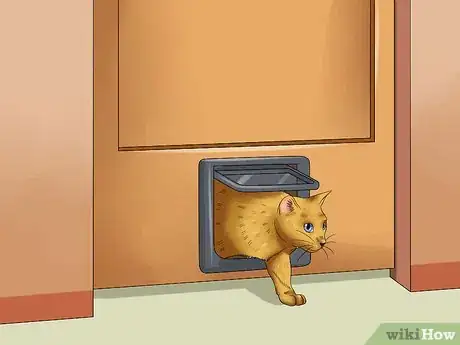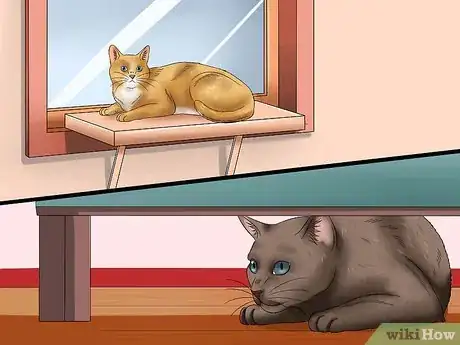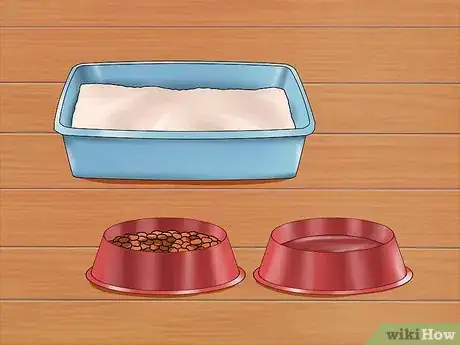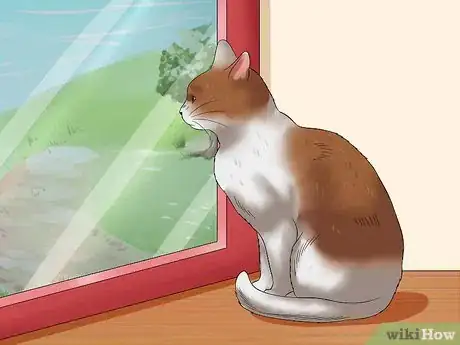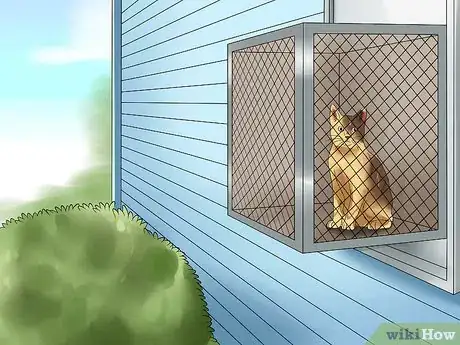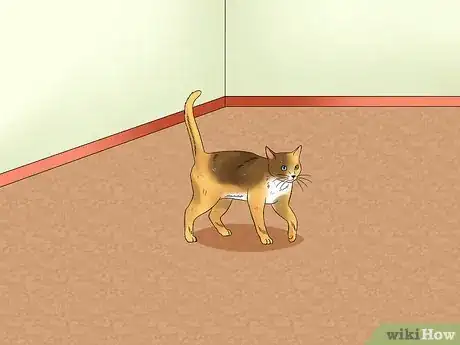This article was co-authored by Jean Johnson. Jean Johnson is a Cat Specialist and a writer for the KittyNook Blog. Jean specializes in providing advice on cat health, play, and general information about cats and cat breeds.
There are 7 references cited in this article, which can be found at the bottom of the page.
wikiHow marks an article as reader-approved once it receives enough positive feedback. In this case, 93% of readers who voted found the article helpful, earning it our reader-approved status.
This article has been viewed 105,869 times.
Do you want to provide your cat with a safe and comfortable place to sleep, eat, play, and curl up? If you have a spare room in your house, you can turn it into a cat-approved sanctuary by following a few simple steps. Cats love to perch, hide, observe, and play, so make sure to keep these needs in mind when designing your cat room.
Steps
Creating a Safe Space
-
1Make it private. Your cat will feel much more comfortable in her new space if she doesn't have to worry about intruders constantly coming in. When choosing a room for your cat, try to make it one that does not get much traffic from the rest of your household, especially from guests.[1]
- If you have dogs, you want to make sure that they do not have access to the cat room, as your cat will probably use the room as a way to escape from the dogs. To do this, install a small cat door that is big enough for your cat, but not for your dogs. You can also block the area off with a gate that your cat can jump over, but your dogs cannot.
- If you have other cats, give your new cat some space to itself while it settles into your home.[2]
- If you don't have room in your house to devote a room 100% to your cat, try sharing a quiet room with her. It's fine for you to be in the room with her from time to time. A laundry room or seldom-used office would work nicely.
-
2Make it safe. Remove anything from the room that may cause a potential hazard for your cat. This includes cords and wires, toxic plants, and anything else that you don't want your cat to put in her mouth.[3]
- If you need to store cleaning products or other potentially toxic substances in the room, make sure they are in a cabinet that closes securely so that your cat will not be able to access them.[4]
- You should also remove anything that your cat might be able to knock over, or at least secure it somehow. If you want to keep knickknacks on shelves or tables in the room, consider securing them to a surface with removable museum putty so your cat can't knock them over.
Advertisement -
3Provide perches and hiding places. Cats tend to feel more secure when they are able to sit on a high perch and observe their surroundings from above. Many cats also enjoy enjoy snuggling up out of view in a cozy hiding spot.
- You can buy cat trees from the store to provide your cat with perches, or you can build your own with some wood and scrap pieces of carpet.
- Tall pieces of furniture can also serve as perches as long as your cat is able to jump high enough to get on top of them. If your cat isn't a great jumper, place a shorter piece of furniture, like a small table, next to the higher piece for her to use as a step.
- Good hiding places can be behind or under a piece of furniture, inside the enclosure of a store-bought cat condo, or even inside a cardboard box.[5] Your cat might appreciate it if you put a cat bed or a soft blanket in her favorite hiding spot.
- Providing your cat with multiple options for places to perch and hide is ideal.
-
4Add the necessities. Especially if you have other animals in your house, your cat will feel much more secure if everything she needs is in her safe place. Provide food, water, and a litter box in the cat room.[6]
- Some cats may not want their food, water, and litter box too close to one another. Try to scatter them around the room as much as possible.
- If possible, give your cat multiple options for places to use the litter box and drink water. Providing these amenities both inside and outside of the cat room would be ideal. In general, it is best to provide one water bowl and litter box for each cat you have, plus one extra.
- If you spend a lot of time away from your house, you may want to consider automating your cat room. You can purchase feeders that dispense a set amount of dry cat food at a specified time each day, water fountains that circulate and filter your cat's drinking water, and even self-cleaning litter boxes.
- Providing at least one scratching post is also a good idea, as this will hopefully discourage your cat from clawing other items around your house.
Making the Room Fun for Your Cat
-
1Let her look out the window. Looking outside can be very stimulating to your cat, so make sure there is a window in your cat room and that your cat is able to sit in the window sill.
- If the sill is not large enough for your cat, place a piece of furniture or a shelf directly beneath the window for your cat to sit on. You can also purchase cat perches that are specifically designed to be attached to windows.[7]
- Cats also love windows because they let in the sunshine. Cater to your cat's love of the sun by providing soft places to sleep in areas where the sun shines at different times of the day.
- Large windows, particularly full-length windows and glass doors, might make your cat feel uncomfortable in her space if there are cats or other animals outside. You can make her feel safer by applying an opaque film to the bottom of the window and providing her with a perch from which she can look out the top part of the window, or by placing other items, such as plants or pieces of furniture, in front of the window for your cat to hide behind if necessary.
-
2Give her a taste of the outdoors. If possible, let your indoor cat enjoy the outdoors safely by giving her access to an enclosed outdoor pen or "catio". Position the pen directly outside the cat room and install a cat door to allow your cat to come and go as she pleases.
- You can purchase or build an outdoor cat pen, but make absolutely sure that it is secure enough so that your cat cannot get out and no other animals can get in.[8]
- If you can't give your cat an outdoor enclosure, you can still provide her with some plants to help make her feel like she is outside. Cats like to munch on plants, so be absolutely sure that you choose varieties that are safe for cats. Cat grass is probably the best option, and it's easy to grow yourself.[9]
-
3Provide toys and obstacles. Indoor cats can get bored if they are not provided with stimulating activities. To keep your cat active and entertained, make sure she has a variety of things to do.
- Make climbing a challenging activity by providing a variety of perches and shelves around the room at different heights. If possible, create a climbing course that allows your cat to navigate the entire perimeter of the room without touching the floor.
- Scatter lots of small cat toys, like toy mice, around the room, or place them in a basket that is easy to access for your cat.
- Puzzle toys are a great way to keep your cat busy. You can hide treats or toys in them and your cat will need to figure out how to get them out.[10]
- You can also purchase high-tech toys that are motion-activated or move randomly to keep your cat's stalking instincts sharp.[11]
- To keep things interesting, move things around and add new challenges on a regular basis.[12]
- Keep in mind that cats don't need expensive toys to be entertained. A winding tunnel made out of a series of cardboard boxes could provide hours of fun! Be creative.
Decorating Your Cat Room
-
1Paint it. Your cat won't really care what the room looks like, as long as it has plenty of cat-friendly elements, so this part is for you. Paint the room a fun color and decorate the walls with hearts, fish, mice, or nature pictures.
- Wall decals, removable wall paper, and stencils are all relatively inexpensive ways to add some interest to an otherwise boring wall.
-
2Think about the flooring. The flooring that is already in your room may be fine, but if you need new flooring, make sure that it is cat friendly. You will want to choose something that is durable and easy to keep clean.
- If your cat tends to have accidents outside of her litter box, you should probably avoid carpet and hardwood flooring. Tile, vinyl, and linoleum are much easier to clean. If you are converting a room with a concrete floor, such as a basement laundry room, you can also apply an epoxy finish to the floor.
- If the flooring you choose is cold and hard, like tile, consider adding some inexpensive and machine-washable throw rugs.
-
3Show off pictures of your cat. Attach pictures to a bulletin board, frame them, or attach poster-sized printouts of your cat to your walls.
- To enhance the cat theme, add some extra posters and knickknacks with pictures of cats, paw prints, or fish. If you have shelves, you can adorn them with books about cats.
-
4Give yourself a place to hang out with your cat. You probably want to make your cat room comfortable for humans as well so that you can spend some time cuddling and playing with your cat. Make sure to put a comfortable couch or chair in the room.
- You can also add a television if you plan on spending time in the room with your cat.
- Remember to keep the cat room quiet and calm. It's fine for you to visit her, but don't invite lots of friends to hang out in the cat room.
- When you are in the cat room, let your cat come to you instead of removing her from her perch or hiding spot.
-
5Hide the litter box. If your cat room also serves another purpose and you don't want to look at a litter box, find a creative way to keep it out of sight. You can put it behind a decorative screen or create an enclosure for it. You can even disguise the enclose as a piece of furniture.
References
- ↑ http://jfm.sagepub.com/content/15/3/219.full.pdf+html
- ↑ Jean Johnson. Cat Expert.
- ↑ http://www.humanesociety.org/animals/cats/tips/cat_proofing_your_house.html?referrer=http://www.humanesociety.org/animals/cats/tips/cat_proofing_your_house.html
- ↑ Jean Johnson. Cat Expert.
- ↑ Jean Johnson. Cat Expert.
- ↑ http://icatcare.org/advice/making-your-home-cat-friendly
- ↑ http://icatcare.org/advice/making-your-home-cat-friendly
- ↑ http://www.animalplanet.com/pets/build-a-catio/
- ↑ http://icatcare.org/advice/making-your-home-cat-friendly
About This Article
Creating a room for your cat is a great way to help it feel safe and comfortable in your house. It’s best to use a room with a view, since most cats like to look out of the window. Make sure you get rid of any toxic plants, cleaning products, or exposed wires that could harm your cat. Keep your cat's necessities, like its food and water bowls and litter box, in the room. You can also place a perch, scratching post, and a few toys in the room to keep your cat entertained. Provide a few different hiding spots, like under furniture or inside a cardboard box, so your cat can relax if it feels vulnerable. If you have a dog in your house, consider installing a cat door so it can come and go without your dog disturbing it. For more tips from our Veterinary co-author, including how to decorate your cat room, read on!
